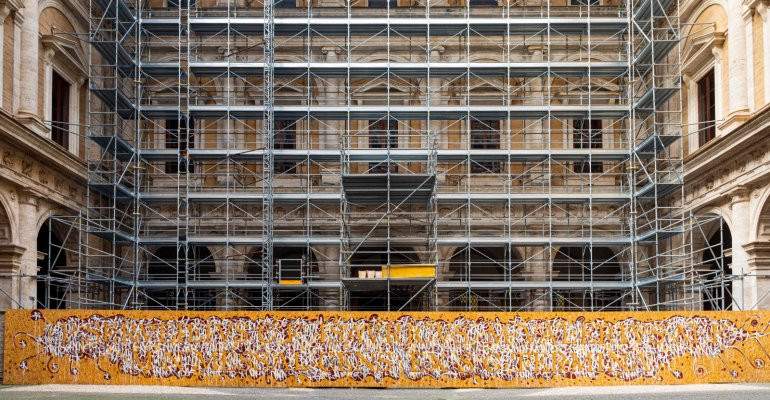JonOne revisits the history of Palazzo Farnese with a monumental work inspired by an ancient memorial stone
As part of the Palazzo Farnese restoration campaign, which will run until 2025, the French Embassy in Italy has been promoting an extensive art enhancement program since July 2021. Street artist and painter JonOne (John Andrew Perello, New York, 1963) has thus created a work, titled Cippo 2.0, inspired by the 55 B.C. cippus located underground, revisiting the history of the palace. During these four years of restoration of the facades and roofs of Palazzo Farnese, the French Ambassador to Italy Christian Masset invited artists to intervene on the palisades, transforming them into creative space.
JonOne therefore created his work on the palisade of the palace’s courtyard, in which history and the contemporary meet. “The idea of bringing ancient and modern together through the cippus as a source of inspiration,” said the artist, “perfectly represents my work. Calligraphy, urban writing, graffiti are at the center of my artistic journey. The calligraphy shown on the cippus has a special significance with respect to what I do today, as writing is also an art form. The inscription made while working on the palisade of Palazzo Farnese was a form of dance, the music transports me, I listen to it while working. It gives an expressiveness to the gestures, to the movements, which are essential for me, because they are for me a way of leisure. Just as people need, more than ever, to dream in these difficult times. In Italy, in Rome, dream and reality get mixed up. Entering Palazzo Farnese is like immersing yourself among treasures that bring past and present together. When I enter here, it is like traveling through time. Understanding history better gives meaning to our everyday lives. In Italy, all places are very special, and it is the incredible energy that emanates from this country that takes on its full dimension here.”
JonOne was inspired by an archaeological find discovered in the basement of the palace, namely a cippus from 55 B.C. on which a Latin inscription can be read. Dating back to Roman antiquity, the artist quotes the text to resurrect it, drawing attention to a little-known aspect of the Renaissance palace. Discovered through excavations in the early twentieth century and studied in particular by members of the École française de Rome, this stone counts about twenty stelae or cippus found along the banks of the Tiber. The cippus is still placed in its original position. The decipherable Latin inscription refers to theintervention of two of Rome’s most importantmagistrates, the censors, who were in charge of the census of the population; they were also entrusted with the administration of the public spaces and land holdings of the city of Rome. “Publius Servilius Isauricus, son of Caius, Marcus Valerius Messalla, son of Marcus, nephew of Manius, censors, delimited (this area) by the decision of the Senate,” this what it reads.
Publius Servilius Isauricus and Marcus Valerius Messalla were censors, active between the years 55-54 BCE. Their intervention is thought to have been related to the demarcation of a reserved space along the banks of the Tiber to ensure its public vocation. At times, it has been thought that the aim of this intervention was to prevent construction in order to contain the risks of flooding in the event of a flood of the river. The censors’ activity probably aimed to regularize a situation in which private constructions hindered the exploitation of the banks for navigation, fishing, or maintenance. After more than 2,000 years, JonOne appropriates this ancient inscription, draws inspiration from its aesthetics, and inserts it into a composition whose chromatic range was chosen to dialogue with the architecture of the building, in a play of echoes and subtle contrasts, which builds through the superimposition of colored layers, making this text appear, elliptical and at the same time enigmatic.
JonOne’s work also recalls the presence of about a hundred graffiti and inscriptions rediscovered during the restoration of the Carracci Gallery in 2014. The fresco ornaments, created between 1597 and 1608 by the brothers Annibale and Agostino Carracci, inspired numerous students and artists from the academies, particularly during the 18th century, leaving as evidence drawings, autographs, details of anatomy, portraits and other graffiti made with lead pencil or sanguine, near the opening of the windows. These ancient “writers” had thus already marked the walls of a palace that established itself as the site of eternally renewed inspiration.
The work created by JonOne for the courtyard of Palazzo Farnese will be accessible to the public on the occasion of the resumption of guided tours of the palace: it will again be possible to visit Palazzo Farnese starting Nov. 20, 2021, after booking online at www.visite-palazzofarnese.it. The work will be extended, in March 2022, by another creation, on the palisade in Via dei Farnesi, in dialogue with students from the Academy of Fine Arts in Rome and young Italian artists.
For Cippo 2.0, JonOne is accompanied by Lefranc Bourgeois, who has been making colors and materials for artists for three hundred years. Flashe paint was the artist’s choice for this monumental work.
Photo Credit Christian Mantuano
 |
| JonOne revisits the history of Palazzo Farnese with a monumental work inspired by an ancient memorial stone |
Warning: the translation into English of the original Italian article was created using automatic tools. We undertake to review all articles, but we do not guarantee the total absence of inaccuracies in the translation due to the program. You can find the original by clicking on the ITA button. If you find any mistake,please contact us.




























